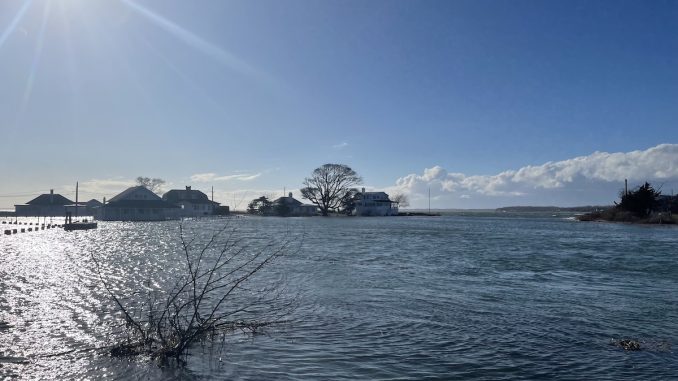
Jack Gibbons is a retired high-school teacher, adjunct professor of education at Long Island University and author of ‘Human-caused Global Warming and Climate Change: Understanding the Science.’ He lives in Cutchogue.
Q – On Jan. 13, the North Fork saw tides that, to some, equaled or were higher than during Superstorm Sandy. Is this a one-off situation that we may not see again? Or, more critically, is this the future?
A – Unfortunately, the future will see an increasing number of flooding events due to sea level rise. The current measured sea level rise we are experiencing is caused by global warming, which is unequivocally caused by human activities. Sea levels will rise indefinitely until global warming stops.
Q – What made this tide so high? There was a new moon on Jan. 11, and the next full moon is the 24th? Why was this so high?
A – I was surprised by the degree of flooding we saw here in Southold Town. I believe we are seeing the ocean’s response to absorbing a record amount of heat in 2023, which saw a huge jump over previous years. Last year, according to National Oceanic and Atmospheric Administration, the oceans soaked up 9 to 15 “zettajoules” of heat more than 2022. One “zettajoule” of energy is roughly equivalent to 10 times the electricity generated worldwide in a year. Absorbing that amount of heat causes thermal expansion of the oceans. As ocean waters warm, they expand slightly, lifting global sea levels.
Q – What does the science and the National Oceanic and Atmospheric Administration tell us about sea level rise here in the Atlantic that will impact the Peconic Bay system? How much has it risen? Over what period of time? What science is used to show sea level rise?
A – According to the Environmental Protection Agency, global sea levels, on average, have increased by 10 inches since 1880. Regarding projected future sea level rise, NOAA’s 2022 Sea Level Rise Technical Report, states: “Sea level along the U.S. coastline is projected to rise, on average, 10 to 12 inches in the next 30 years (2020 to 2050), which will be as much as the rise measured over the last 100 years.” On the U.S. East Coast, the sea is rising about 1 inch every 3 years. Two methods are used to measure sea level rise: tide gauges and satellite altimeters.
Q – What are the best science-based predictions on sea level rise in the coming years? What is causing this rise?
A – Future sea level rise depends entirely on human emissions of greenhouse gases, primarily carbon dioxide from burning fossil fuels. Again, to quote NOAA, “Current and future emissions matter. About 2 feet of sea level rise along the U.S. coastline is increasingly likely between 2020 and 2100 because of emissions to date. Failing to curb future emissions could cause an additional 1.5 to 5 feet of rise for a total of 3.5 to 7 feet by the end of the century.”
Four factors are driving sea level rise, and three are increasing as a direct result of global warming. First, the oceans are absorbing heat at a record rate, which causes thermal expansion — the waters of the oceans are expanding pushing up sea levels. Second, melting polar ice caps are adding water to the oceans; more water, higher tides. Third, the East and Gulf Coasts are sinking, a process called rebound subsidence caused by the melting of mile-thick continental ice sheets that covered North America during the last glaciation. Finally, the “Atlantic Meridional Overturning Circulation,” an ocean current that includes the Gulf Stream, is slowing, which allows water to pile up along the coastline.
Q – Due to our geography, the North Fork seems particularly vulnerable to sea level rise and tides like we saw on that recent Saturday. Are there areas of the North Fork, from Riverhead to Orient, that are particularly vulnerable?
A – All low lying areas are vulnerable — the rising seas play no favorites. NOAA has produced a very interesting interactive sea level rise map that allows the reader to enter a location, such as Southold Town, and then adjust the amount of sea level rise to see the areas inundated.
See: coast.noaa.gov/slr.
Q – With climate change, what are your worries about the future?
A – I am deeply concerned about the future of sea level rise until the global community takes serious action to curb emissions of carbon dioxide (and other greenhouse gases). Current emissions of carbon dioxide increase the atmospheric concentration of CO2, which causes global warming. And, again, global warming drives sea level rise. As long as human emissions increase the atmospheric concentration of CO2, the Earth will continue to warm.
This is not an opinion, it is a fact of nature that applies to any Earth-like planet anywhere in the universe. The only way to stop sea level rise is to stop emissions of CO2. According to climate scientists, to hold global warming to the Paris Accord goal of “well below 2C (3.6F) degrees” we must cut CO2 emissions in half by 2050, and cut emissions to net zero by 2100. “Net zero” means any CO2 added to the atmosphere by, for example, necessary industrial processes, must be offset by removing an equivalent amount of CO2 from the atmosphere.

